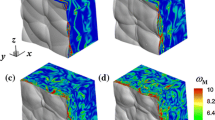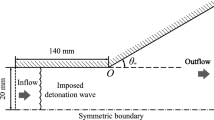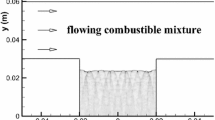Abstract
Cylindrical cellular detonation is numerically investigated by solving two-dimensional reactive Euler equations with a finite volume method on a two-dimensional self-adaptive unstructured mesh. The one-step reversible chemical reaction model is applied to simplify the control parameters of chemical reaction. Numerical results demonstrate the evolution of cellular cell splitting of cylindrical cellular detonation explored in experimentas. Split of cellular structures shows different features in the near-field and far-field from the initiation zone. Variation of the local curvature is a key factor in the behavior of cell split of cylindrical cellular detonation in propagation. Numerical results show that split of cellular structures comes from the self-organization of transverse waves corresponding to the development of small disturbances along the detonation front related to detonation instability.
Similar content being viewed by others
References
Lee J H S, Lee B. Cylindrical imploding shock waves[J]. Physics of Fluids, 1965, 8(12):2148–2152.
Sun C W, Wei Y Z, Zhou Z K. Applied detonation physics[M]. Beijing: Defense Industry Press, 2000, 3: p90–94 (in Chinese).
Lee J H S. Initiation of gaseous detonation[J]. Ann Rev Phys Chem, 1977, 28(3):75–104.
Erpenbeck J J. Detonation stability for disturbance of small transverse wavelength[J]. Physics of Fluids, 1966, 9:1293–1306.
Zaidel R M, Zeldovich Y B. One-dimensional instability and attenuation of detonation[J]. Zh Prikl Mekh i Tekh Fiz, 1963, (6):59–65.
Alpert R L, Toong T Y. Periodicity in exothermic hypersonic flows about blunt projectiles[J]. Astronaut Acta, 1962, 17:539–560.
Sun M. Numerical and experimental studies of shock wave interaction with bodies[D]. Ph D dissertation. Tohoku University, Japan, 1998.
Li H H. Experimental and numerical study on unsteady complex flow and wave interaction[D]. Ph D dissertation. University of Science & Technology of China, China, 2005.
Christiane Helzel, Randall J Leveque, Gerald Warnecke. A modified fractional step method for the accurate approximation of detonation waves[J]. Siam J Sci Comput, 2000, 22(4):1489–1510.
Watt S D, Sharpe G J. Linear and nonlinear dynamics of cylindrically and spherically expanding detonation waves[J]. Journal of Fluid Mechanics, 2005, 522(1):329–356.
Wang C, Jiang Z L. Numerical simulation of the cellular structure evolution in cylindrically diverging detonation[C]. In: Hannemann Klaus, Seiler Friedrich (eds). Proceeding of 26th International Symposium on Shock Waves, Gottingen, Germany: Springer-Verlag, July 2007.
Han G L, Jiang Z L, Wang C, Zhang F. Cellular cell bifurcation of cylindrical detonations[J]. Chinese Physics Letters, 2008, 25(6):2125–2127.
Author information
Authors and Affiliations
Corresponding author
Additional information
(Communicated by ZHOU Zhe-wei)
Project supported by the National Natural Science Foundation of China (No. 90205027) and China Postdoctoral Science Foundation (No. 2005037444)
Rights and permissions
About this article
Cite this article
Wang, C., Jiang, Zl., Hu, Zm. et al. Numerical investigation on evolution of cylindrical cellular detonation. Appl. Math. Mech.-Engl. Ed. 29, 1487–1494 (2008). https://doi.org/10.1007/s10483-008-1109-y
Received:
Revised:
Published:
Issue Date:
DOI: https://doi.org/10.1007/s10483-008-1109-y




